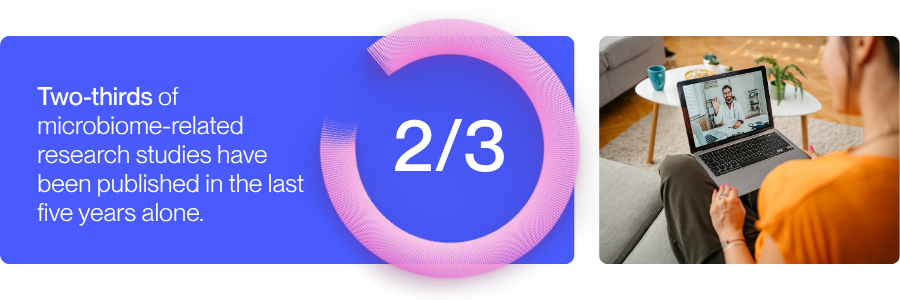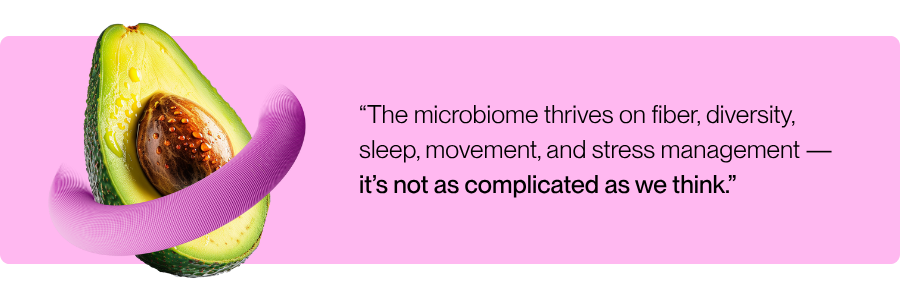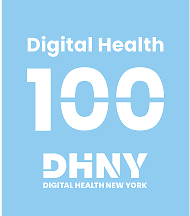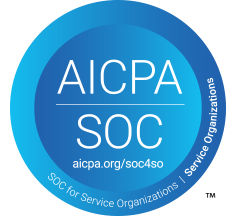The gut microbiome is one of the most complex and promising frontiers in human health and one of the most misunderstood. In this Clinical Spotlight, Yael Horwitz, MPH, Cylinder’s Director of Clinical Product and Programs, shares personal reflections and professional insights on what the science really says. From what we can (and can’t) learn from microbiome testing to the dietary habits that matter most, Yael offers a clear-eyed view into this rapidly evolving field grounded in evidence, equity, and curiosity.
Q: How did you first get interested in the gut microbiome?
I’m not an expert on the microbiome, but I would consider myself an enthusiastic and relatively informed consumer. I first started learning about the microbiome 15 years ago, after I was diagnosed with a rare autoinflammatory disease. There weren’t any FDA-approved treatment options for my condition, but the doctor who diagnosed me told me that one of his colleagues was researching fecal transplants, and the future of my treatment may very well be based on microbiome science.
I think my doctor probably thought he was freaking me out by talking to a teenage girl about stool, but I was really intrigued. I went home and read as much as I could about the microbiome at the time. It became something that gave me a lot of hope as well as something that helped me learn about the human body over the course of my chronic illness journey.
Q: What role should microbiome data play in clinical care?
When I first started learning about the microbiome, I was hopeful that it held the answers to a lot of our biggest unanswered questions about human health. I still think it’s an extremely promising space, but now that I’m better educated—and the state of research is much further along than it was 15 years ago.
I like to say that forward progress is often backward progress when it comes to microbiome science. That is to say, we are continually learning more about everything the microbiome does to support our health, but we are also learning more about the potential risks and consequences of messing with someone’s microbiome.
Microbiome research is not mature enough yet to be used for clinical decision-making in most cases (especially outside of research settings). With that said, microbiome testing can provide helpful clues about what might be happening inside someone’s gut, particularly in combination with information about someone’s symptoms, diet, lifestyle, and other information about that individual’s health.
Q: What are the limits of what we know, and how should that shape care?
Two-thirds of microbiome-related research studies have been published in the last five years alone. At this point in time, evidence-based applications for microbiome data in clinical care are relatively limited, with fecal microbiota transplants (FMTs) for the treatment of C. Diff infections being the only FDA-approved microbiome-based therapeutic at this point in time.
We still have a lot to learn about the bacteria that live in the human gut and other parts of our bodies, and it’s important to bear in mind that bacteria make up only a fraction of the microbiome. There are other organisms that live inside us that are just as important and we know even less about their role in human health, like fungi, viruses, and phages.
There are some aspects of the microbiome that are pretty well established health indicators. For example, low microbial diversity is correlated with worse health outcomes, and we feel confident that some types of bacteria play a helpful role in the gut, while others are probably undesirable.

Q: How should providers think about microbiome testing?
Microbiome testing should not replace evidence-based clinical evaluation, including evaluation of an individual’s symptoms, diagnostic testing, etc. In some scenarios, it may be a helpful companion tool, but I tend to think of it more as a ‘nice-to-have,’ rather than a ‘need-to-have.’
However, it can be a really compelling engagement tool and a powerful way for people to actually see the impact of their diet and lifestyle on their digestive health. For example, someone who’s eating a diet that’s very low in fiber or not very diverse may be able to see the impact of those behaviors in their microbiome test results in the form of low microbiome diversity, low abundance of keystone species (helpful species that support gut health), and potentially other results that deviate from what would typically be seen in a healthy gut.
I often remind people that colonoscopies are not an intriguing way to get people interested in their gut health. In fact, I think they’re probably one of the least appealing things in health care, and a lot of the messaging that people receive from providers and health insurers related to digestive health still focuses on them. In my opinion, there’s clinical value in any tool that effectively helps people get interested and engaged in their health and wellbeing.
Q: What should people know about probiotics, diet, or microbiome-targeted interventions?
The first thing I always tell people is that microbiome-based interventions don’t come without risk. I’ve heard people say “what’s the worst that could happen” in regards to trying probiotic supplements, and the honest answer is, we don’t really know.
Probiotic supplements typically have limited oversight from the FDA. Beyond that, we don’t have a strong idea of what a “healthy” vs. “unhealthy” microbiome looks like, particularly for a given individual, so it’s hard to know exactly what someone should do to make their microbiome healthier.
There are not well established reference ranges for what constitutes healthy levels of many bacteria that live in the gut. Even when we have high confidence that certain bacterial species or strains are beneficial for human health, we often don’t know what the healthy upper limit for that bacteria is.
Taking a probiotic supplement could potentially introduce too much of a given bacteria to the gut or have unintended consequences that are hard to anticipate. Some probiotics have strong safety profiles and compelling outcomes, but for the average person, it’s probably going to be easier and more cost effective to focus on diet.
When it comes to diet, my advice would be not to overcomplicate things; the microbiome likes fiber and dietary diversity, and doesn’t love ultraprocessed foods or too much sugar. Research on targeted microbiome-based therapeutics is growing rapidly, so it will be really interesting to see how this space evolves over the next few years.

Q: What’s the biggest misconception people have about gut health?
I think people tend to believe that microbiome health is complicated. The microbiome itself is definitely complex, but for the average person, the healthy habits that support good microbiome health are mostly common sense.
Like other aspects of human health, the microbiome thrives when someone manages their stress, sleeps well, exercises regularly, stays hydrated, and eats a nutritious diet. To elaborate on what I said above, a diet that’s good for the microbiome is typically going to be low in ultraprocessed foods, low in sugar and refined carbohydrates, high in fiber, and diverse.
A diverse microbiome, one where many different types of bacteria thrive, comes in part from eating a diverse diet. I think this is really fun advice; I would encourage people to shop the rainbow (fill your grocery cart with lots of different colors, especially in the produce section) and to not be overly restrictive in their food choices if they don’t need to be.
This is a great way to ensure that you’re eating lots of different types of prebiotic fibers that feed different types of bacteria in the gut.
Q: What are your favorite habits for microbiome health?
Learning about the microbiome helped me reconnect with the joy of food and eating during a time in my life when I really needed it. Like many people, especially when I was a young woman navigating complex chronic illness, I’ve gone through periods of my life where I’ve eaten very restrictively in an attempt to control some aspect of my health or appearance.
Dietary advice for microbiome health has challenged a lot of the misguided ideas I’ve picked up about what constitutes a “healthy diet” over the years. It was empowering to learn that a healthy microbiome is typically better supported by a diet that includes lots of different foods, rather than one that cuts out certain food groups.
I’ve learned to prioritize a diet that’s rich in fiber, rather than one that’s low in carbs, and a diet that favors unprocessed foods, rather than one that’s low in calories. For example, rice and potatoes are excellent sources of resistant starch, a type of fiber that’s very important for feeding healthy gut bacteria, once they’ve been cooked and fully cooled (feel free to reheat them)!
I also include a lot of probiotic or fermented foods in my diet. Every culture I can think of has some sort of traditional fermented food, so it can be really fun to try different kinds and learn about fermented foods from your own culture. I’ve also dabbled in making fermented foods at home—it’s surprisingly easy!
While microbiome science is still emerging, one thing is certain: sustainable, evidence-based habits, like increasing fiber, supporting dietary diversity, and managing stress, remain the foundation of good gut health. At Cylinder, we don’t treat data in isolation. Our care teams use clinical insight, member-reported outcomes, and whole-person context to guide every recommendation. As research evolves, we’ll continue to bring curiosity, rigor, and a commitment to what matters most: helping people feel better and stay better.







